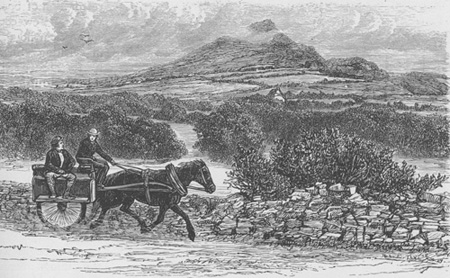The Scalp, County Wicklow - Irish Pictures (1888)
From Irish Pictures Drawn with Pen and Pencil (1888) by Richard Lovett
Chapter II: The Garden of Ireland … continued
« Previous Page | Start of Chapter | Book Contents | Next Page »
On the road from Enniskerry to Dublin, and within an easy drive of Bray, is a wild ravine known as the Scalp. The road runs over a shoulder of Shankhill Mountain and through this ravine; it presents a very wild appearance, enormous masses of granite being heaped up in grand and picturesque confusion on either side. It looks as if nature, in order to spare man the trouble of blasting a road, had by some mighty convulsion torn a rent through the mountain just wide enough for a high road. Professor Hill has shown that the Scalp was once the channel of a great river that drained districts of land, now denuded of extensive rock deposits, and which discharged itself through the Irish Sea in distant ages. From the south entrance a very fine view is obtained, having in the foreground the Greater and the Lesser Sugar Loaf Mountains.
Another pleasant trip is along the road which skirts the foot of the Great Sugar Loaf Mountain, passing through the Glen of Downs, another of these lovely Wicklow dells. It consists of a deep, well-wooded ravine, the banks at some points rising to a height of 800 feet. The road runs to Delgany, whence the return to Bray is direct.
But, as we have already suggested, he who would rightly appreciate the scenery of this part of Ireland must go somewhat further afield. In the central and southern part of Wicklow are to be found the finest examples both of the softer and lovely country, and also of the sterner, gloomy and wild mountain scenery. The centre towards which all excursions in this region tend by a very natural attraction is the Vale of Glendalough; and the reason for this is not far to seek. It is one of the loveliest spots upon which the eye can rest. It is associated, like so many other beautiful parts of Ireland, with the past history and religious life of the nation; and the national tendency to associate romance and tragedy with exceptional natural features is well illustrated here.
« Previous Page | Start of Chapter | Book Contents | Next Page »


